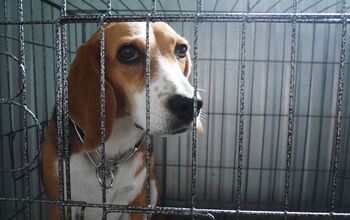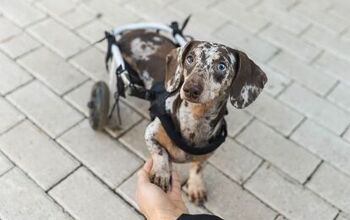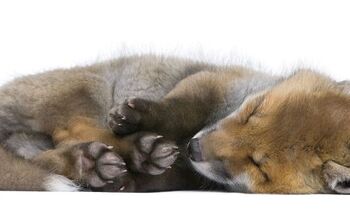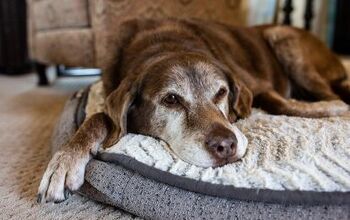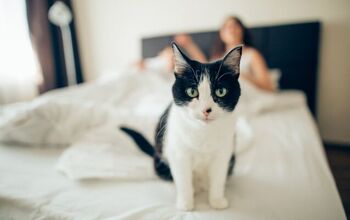Golden Boxer


About Golden Boxer
The loyal and loving Golden Boxer is a wonderful, protective family pet that brings together the best of two large breed dogs; the gentle, friendly nature of everyone’s favorite Golden Retriever and the playful, clown-like personality of the animated looking Boxer. Of course the upside with a dog of this lineage is that you get a sociable, tolerant pup that loves to be included in all family activities. He’s also a highly alert dog that can be cautious around new faces and therefore ideal watchdog material. The only downside to this wonderful pooch is that both parent breeds absolutely thrive on human companionship and as a result the Golden Boxer isn’t a dog that can be left on his own for long periods of time. Boredom, restlessness and even separation anxiety can result in a pooch that takes on destructive behaviors such as chewing things he shouldn’t and constant barking.
The loving, family-friendly Golden Boxer brings together the gentle Golden Retriever and the playful Boxer.
The Golden Boxer is considered a Designer Dog – a term that first became popular back in the 1980’s and refers to the crossing of two (and possibly three) pure-bred dogs in order to arrive at a pup that is healthier, sometimes non-shedding and often smaller and gentler than many of the popular breeds of the day. With the Golden Boxer, his parent breeds are the Golden Retriever and the Boxer and while his Designer status means he himself is a relatively new breed, both parents have some pretty impressive history. The Golden Retriever was developed in Scotland back in the mid-1800’s as a solution to the hunters’ need for a dog that was adept at retrieving downed waterfowl on both land and in water. Today, there are British, American and Canadian variations on this popular breed all of which include a gentle, sweet-natured personality. Now in spite of the Boxer originating in late 1800’s Germany, he actually has some Old English Bulldog in him (no surprise given the jowls and distinct under-bite). Bred for use as a guard dog, he found his true calling in the early 1900’s when he came to America and was soon put to use as messenger and guard dog in World War I.
Because the American Kennel Club (AKC) is committed to advocating for pure-bred dogs over mixed breeds, a Designer Dog such as the Golden Boxer doesn’t qualify to join its coveted registry. That said, both of this dog’s parent breeds are long time AKC members who have proven to be a couple of the most highly popular breeds with North American families. The Golden Retriever was inducted back in 1925 to the AKC “sporting” group and is described as a friendly, intelligent and devoted dog. The Boxer became a member of the “working” group in 1904 and he’s considered to be a bright, fun-loving and active pooch.
Golden Boxers make an ideal pet for an active, fun-loving family.
Its important that every dog be fed a high-quality, nutritious diet that is specifically designed to meet his needs from a size, age and activity level. With your Golden Boxer being a muscular, highly active pooch, you will want a protein-rich diet that keeps him satisfied and doesn’t leave him feeling hungry throughout the day. As the Boxer in him may be prone to episodes of bloat, it’s important he not be fed large volumes of food at once, but have smaller meals staggered 2 to 3 times throughout the day with plenty of fresh water and exercise planned for no sooner than 1 hour after feeding. This dog does have a high tendency to become obese and that coupled with his propensity toward joint issues later in life means you need to establish and maintain an ideal weight by not allowing him to over-eat. Now let’s face it, a hungry dog that is constantly begging for a tasty hand-out is never ideal so choose his food and treats carefully. Again, high-protein is important because it will help him feel full while a kibble that is high in fillers (carbohydrates) will only cause him to want to keep eating in order to feel satisfied.
This dog comes from two breeds that are not only intelligent, but also very eager-to-please so picking up and obeying commands will come easily and more quickly than with most dogs. You should never forget that socialization is a key part of the training process and with the Golden Boxer this should begin at a very early age through exposure to new people, places and situations including puppy training classes to encourage a comfort level with different experiences and discourage anxious and sometimes aggressive behaviors. As with most dogs, the Golden Boxer does best when he’s trained using a positive, rewards-based approach that provides him with lots of verbal praise, appreciative pats and his favorite treats for a job well done. Because he is a devout people-pleaser, obedience training where he has the opportunity to show you how well he can pick up and respond to your commands – with suitable cheer-leading from you – will go a long way in building a positive bond between the two of you.
Once he reaches adulthood (close to the 2 year mark), a healthy weight for this solidly built dog will land somewhere between 60 and 80 pounds depending on gender and which side of the DNA pool his genes lean toward.
Golden Boxers make an ideal pet for an active, fun-loving family. They’re loyal, affectionate and they get along well with kids and other animals, including other dogs. A slight wariness of strangers comes from the Boxer side of this pooch and makes him an ideal yet non-aggressive watchdog who will readily bark to alert his family pack to a new face, strange sound or perceived danger. This pooch absolutely thrives on human interaction and in spite of his large size and outdoorsy background, he should never be considered an outdoor dog – he loves his people too much and needs the social interaction that comes with being a key part of his family’s activities. Of course, the downside to all of this is that you have a dog that really doesn’t do well when left on his own for long periods of time. He can become anxious and take on destructive behaviors that include chewing or constant barking. Similarly, if he doesn’t receive regular daily exercise and interactive playtime to help him burn off some of his boundless energy, he can act out and develop similarly bad habits. So the lesson here is that only those with time to keep this beautiful boy fit and mentally stimulated, will want to consider bringing him into their home!
While Designer Dogs are typically healthier than their pure-bred parents, it’s always important to do your research to understand what your new pup may inherit from either or both of his parents down the line. With the Golden Boxer, that can include certain cancers from the Golden Retriever as well as joint issues such as dysplasia and degenerative myelopathy, Von Willebrand’s, bloat, heart problems, hypothyroidism and even deafness from the Boxer. Although this may seem like an intimidating list of ailments, the Golden Boxer is still considered a hale and hearty dog that may well never experience any of these health issues throughout his lifetime.
With regular exercise, a top-quality food and regular preventative maintenance check-ups with your vet, you can expect your Golden Boxer to live between 10 and 14 years; slightly longer than the average medium-sized dog.
Spending time with your Golden Boxer while out on walks, jogs, runs or just tossing a ball in the yard is an important bonding process that is great for both his physical well-being and his mental health. This is a highly active dog and you can expect him to need a minimum of one long walk lasting around one hour or more (or two shorter walks) each day as well as some vigorous, active playtime that can include running and agility games such as catching a frisbee or chasing a ball across the backyard or an open field. Visits to an off-leash dog park are another great way for him to burn off some energy, engage with other dogs and brush up on his socialization skills with people and pooches alike. Failure to meet his need to burn off steam and be mentally stimulated can result in him developing behavioral issues such as chewing and barking.
The Golden Boxer thrives on human interaction and can become destructive when left on his own for long periods.
The Golden Boxer is also known by the name Golden Boxer Retriever and because this dog is a cross of two different breeds, he doesn’t qualify to become a member of the coveted American Kennel Club (AKC) – an organization whose roster is dedicated solely to pure-bred dogs. That said, there are other, lesser known registries that have surfaced specifically to recognize designer dog breeds and as a result, the Golden Boxer is a fully-fledged member of the Designer Breed Registry (DBR) and the Dog Registry of America, Inc. (DRA).
Regardless of whether your Golden Boxer inherits the thick, double-coat of the Golden Retriever (who is known to shed throughout the year) or the short, thinner coat of the Boxer who is a much lighter shedder and can easily make do with brushing just once a week, it’s fair to say you can expect this new family member to require daily brushing in order to keep his coat looking its best, stay free of tangles and prevent loose hair from becoming an issue in your home and vehicle. Yes, in spite of the short, slick, low-shedding coat that the Boxer brings to this mix, your boy is still considered to be a moderate-shedder and while bathing and professional grooming won’t be required, brushing will need to be part of his (and your) daily ritual. And because floppy-eared dogs are prone to smelly yeast infections due to a lack of air movement around the ear canal, a weekly ear inspection and simple cleaning that includes soft, damp cotton balls will go a long way to keeping his ears dirt and debris-free and preventing those funky-smelling issues.
Golden Boxers will typically have a litter of between 8 to 12 good sized puppies that do well with gentle handling from the time they arrive. These pups are the offspring of two highly intelligent breeds that are naturally friendly but may also be cautious with strangers and as a result, they will benefit greatly from early socialization that can help expose them to new places, new faces, other animals and exciting new situations. “Early” can be described as between 2 and 4 months and it should always be done slowly and gently to help the pup build confidence and keep all these new interactions positive and controlled. Your smallest family member will also have a very healthy appetite that needs to be monitored and capped as he reaches maturity (near the 2-year mark). Obesity from over-eating and continuously receiving fatty or carb-laden treats can be a problem with the Golden Boxer and when coupled with potential joint issues later in life, this can present serious and painful problems as he ages and seriously compromise his quality of life.
Photo credit: kung_tom/Shutterstock; CHONG JIAN MING/Shutterstock; mink.snn/Shutterstock

Sharing space with three seriously judgy Schnoodles and a feline who prefers to be left alone. #LivingMyBestLife
More by Mary Simpson
















